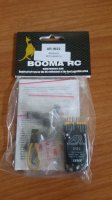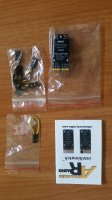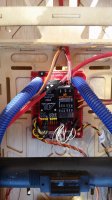njswede
150cc
[h=1]Introduction[/h]
Servo matching on ganged surfaces always seemed like black magic performed only by the seasoned giant scale pros. So when I got my first 100cc-plane and had to set up ganged aileron surfaces, I felt a bit intimidated. To make matters worse, doing this matching in my transmitter wouldn't be possible, since I have a measly 8 channels. So I took to Google and started looking for some kind of matching device. The JR Matchbox seems like what most people go for, but I also found a much lesser known device called thed Booma Intellimatch IM22. Since it claimed to be fully automatic and was cheaper than two matchboxes, it seemed like an interesting alternative.
[h=1]Product variants[/h]
The Booma RC Intellimatch comes in two flavors: The IM22, which can take two inputs and drive two servos per channel (for a total of four) or the IM14, which takes a single input and drives four ganged servos based on that channel. Since I have two ailerons with two servos each, the IM22 is the obvious choice for me.
[h=1]Unboxing and first impressions[/h]
The IM22 comes in a small bag with all the cabling and hardware needed for installation. This includes a bind plug and some heavy-duty velcro for mounting the device.


The build quality seems top notch and the electronics are well protected inside the device. They also seem to be covered in epoxy or something similar. The only minus would be the male-male wires for hooking the device up to the radio/power bus. They are only about 1.5" long, which makes placement of the device a bit tricky. It's probably done to make minimize signal loss and interference, but it introduces a few challenges when installing.
[h=1]Installation[/h]
Once you've found a good spot for the device (which can be a bit challenging due to the short wires), installation is a breeze. Just anchor it using the supplied heavy-duty velcro and hook up the inputs. If you have a power distribution unit, you have to hook up the Intellimatch AFTER the power distribution, i.e. between the power distributioin and the servos. The reason for that is that the Intellimatch works by sensing the current flowing to the servos, so the power has to pass through it. There's an extra power input, so my four servos are fed through three wires from the power distribution.
Here is what it looks like in my plane:

[h=1]Configuration[/h]
Now for the fun part! Once the Intellimatch is installed, it's time to configure it. I started with my right aileron. FIrst I plugged in my "master servo". This could really be any servo, but I picked the inboard one. Then I plug in the second servo. The servos should be reasonably matched mechanically, or you'll have serious binding and may damage the servo or control surface. Once the second servo is plugged in, you install the "bind plug" that comes with the device and press a button to start the matching sequence. The Intellimatch start by determining the endpoints. Then it will step through 100 points across the servo throws and calibrate each point. It takes about a second for each point to be calibrated, so the whole process takes about two minutes per control surface. When it's done, you need to remove the bind plug and cycle the power. And THAT'S IT!
This is different from traditional maching as it creates a smooth curve of 100 points, rather than just matching at a mid point and endpoints. In fact, since the Intellimatch smoothes the curve between the 100 points, creating a 8192 point curve, you should have perfectly matched servos across the entire range.
The way the Intellimatch works is pretty clever. It seems to match the servos by measuring the current and trying to minimize it. A servo at rest should draw very little current, but if two servos are "fighting each other", they will obviously consume more power. So the Intellimatch tries different matching settings until it finds one that draws as little current as possible.
[h=1]Conslusion[/h]
For a giant-scale newbie like me who thinks servo matching is a bit intimidating, this little device is a life saver! It's really just as simple as plugging it in and pressing a button! The only minus would be the short wires, which makes installation a little bit challenging.
The Booma RC Intellimatch IM22 costs $89 USD (plus shipping) and is designed and manufactured by Booma RC in Australia: http://www.boomarc.com/en/
It is distributed in the US by Duralite Flight Systems: https://duraliteflightsystems.com
Servo matching on ganged surfaces always seemed like black magic performed only by the seasoned giant scale pros. So when I got my first 100cc-plane and had to set up ganged aileron surfaces, I felt a bit intimidated. To make matters worse, doing this matching in my transmitter wouldn't be possible, since I have a measly 8 channels. So I took to Google and started looking for some kind of matching device. The JR Matchbox seems like what most people go for, but I also found a much lesser known device called thed Booma Intellimatch IM22. Since it claimed to be fully automatic and was cheaper than two matchboxes, it seemed like an interesting alternative.
[h=1]Product variants[/h]
The Booma RC Intellimatch comes in two flavors: The IM22, which can take two inputs and drive two servos per channel (for a total of four) or the IM14, which takes a single input and drives four ganged servos based on that channel. Since I have two ailerons with two servos each, the IM22 is the obvious choice for me.
[h=1]Unboxing and first impressions[/h]
The IM22 comes in a small bag with all the cabling and hardware needed for installation. This includes a bind plug and some heavy-duty velcro for mounting the device.


The build quality seems top notch and the electronics are well protected inside the device. They also seem to be covered in epoxy or something similar. The only minus would be the male-male wires for hooking the device up to the radio/power bus. They are only about 1.5" long, which makes placement of the device a bit tricky. It's probably done to make minimize signal loss and interference, but it introduces a few challenges when installing.
[h=1]Installation[/h]
Once you've found a good spot for the device (which can be a bit challenging due to the short wires), installation is a breeze. Just anchor it using the supplied heavy-duty velcro and hook up the inputs. If you have a power distribution unit, you have to hook up the Intellimatch AFTER the power distribution, i.e. between the power distributioin and the servos. The reason for that is that the Intellimatch works by sensing the current flowing to the servos, so the power has to pass through it. There's an extra power input, so my four servos are fed through three wires from the power distribution.
Here is what it looks like in my plane:

[h=1]Configuration[/h]
Now for the fun part! Once the Intellimatch is installed, it's time to configure it. I started with my right aileron. FIrst I plugged in my "master servo". This could really be any servo, but I picked the inboard one. Then I plug in the second servo. The servos should be reasonably matched mechanically, or you'll have serious binding and may damage the servo or control surface. Once the second servo is plugged in, you install the "bind plug" that comes with the device and press a button to start the matching sequence. The Intellimatch start by determining the endpoints. Then it will step through 100 points across the servo throws and calibrate each point. It takes about a second for each point to be calibrated, so the whole process takes about two minutes per control surface. When it's done, you need to remove the bind plug and cycle the power. And THAT'S IT!
This is different from traditional maching as it creates a smooth curve of 100 points, rather than just matching at a mid point and endpoints. In fact, since the Intellimatch smoothes the curve between the 100 points, creating a 8192 point curve, you should have perfectly matched servos across the entire range.
The way the Intellimatch works is pretty clever. It seems to match the servos by measuring the current and trying to minimize it. A servo at rest should draw very little current, but if two servos are "fighting each other", they will obviously consume more power. So the Intellimatch tries different matching settings until it finds one that draws as little current as possible.
[h=1]Conslusion[/h]
For a giant-scale newbie like me who thinks servo matching is a bit intimidating, this little device is a life saver! It's really just as simple as plugging it in and pressing a button! The only minus would be the short wires, which makes installation a little bit challenging.
The Booma RC Intellimatch IM22 costs $89 USD (plus shipping) and is designed and manufactured by Booma RC in Australia: http://www.boomarc.com/en/
It is distributed in the US by Duralite Flight Systems: https://duraliteflightsystems.com
Last edited by a moderator:
